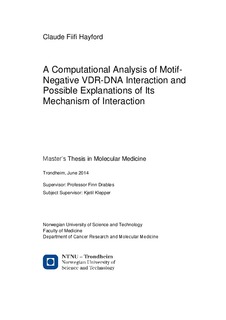A Computational Analysis of Motif-Negative VDR-DNA Interaction and Possible Explanations of Its Mechanism of Interaction
Master thesis
Permanent lenke
http://hdl.handle.net/11250/263707Utgivelsesdato
2014Metadata
Vis full innførselSamlinger
Sammendrag
Transcription factor binding to DNA has generally been assumed to be as a result of the recognition of sequence-specific motifs in the transcription factor binding sites. Recent studies have however shown several examples of transcription factor binding where no recognizable motif was identified. The exact mechanisms by which these associations occur remain unclear, although several explanations have been put forward. By employing MotifLab, a computational tool for the analysis of regulatory regions and data from the ENCODE project, this study examines the properties of these motif-positive and motif-negative regions and how they relate or differ from each other to get a better understanding of the factors that lead to transcription factor binding in these cases. Two well-described Vitamin D receptor datasets where there is a mixture of binding sites both with and without a clear motif is utilised.
The results showed that there are differences between motif-negative regions and motif-positive regions in terms of DNA accessibility, the type of regions in which either type of binding takes place, as well as in the types of motifs that are overrepresented in each case. These findings suggest that VDR binding in motif-negative regions does employ a mechanism different from its sequence-specific binding; however a clear elucidation of this mechanism has not been possible.
